 Facebook
Facebook
 X
X
 Instagram
Instagram
 TikTok
TikTok
 Youtube
Youtube

Many already know and have taken pictures with them as a souvenir from Tijuana, a tradition that started shortly after the city was founded. The zonkey (burro-cebra in Spanish) is Tijuana’s most enduring icon — it even has its own Wikipedia page. The first known picture of a tourist posing with a zonkey is from 1914.
Back then, the quality of the picture would not expose the sepia-toned donkey. Instead, it looked more like a ghostly figure of the animal. Someone had the genius idea to paint the donkey black and white, resulting in what was known as the Tijuana zebra.
(The offspring of the cross between a zebra and donkey do exist but are mainly found in Africa, not Tijuana. See Zebroids.)
When I first encountered a zonkey in 2009, the donkeys seemed malnourished and the black-and-white paint was mostly faded out. The handlers approached aggressively and asked in English if I wanted a picture, almost forcing me to accept. It was hard times for the handlers. The economy was bad, and tourists had abandoned Tijuana. The slow comeback of tourists since then has given handlers a bit more money in their pockets, but nothing compared to their golden days.
In August of 2014, the zonkey tradition became 100 years old and it was declared a cultural heritage icon. The city’s professional basketball team is nicknamed the Zonkeys. But for the past couple of years, animal-rights activists have been organizing peaceful protests to try to get the donkeys off the street. They intend to replace the donkeys with fiberglass replicas made by local artists, a proposal that has not gained traction.
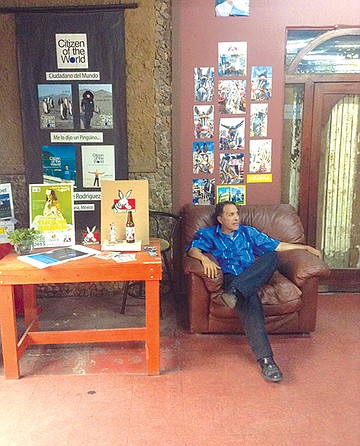
“No, I do not want to talk about it!” said Victor Hugo Zurita in Pasaje Rodríguez. Zurita runs a small shop that is dedicated to honoring Tijuana and its traditions. He is adamant about protecting the zonkeys. “I am tired of the discussion; it is an insult to my intelligence and to my education.” But he continues to talk about the subject passionately.
“These are the best-treated donkeys in the world!” Zurita pounds his desk with his left fist. “All other donkeys suffer more; donkeys are beasts of burden! I respected their movement at first, but these [activists] are people that are not from Tijuana and do not know what this city is about. I am from here; my grandparents moved here in the 1920s. I do everything for this city, and I am tired of people that have it so easy to just write signs about zonkeys suffering and protest in the street.”
The protesters, Zurita says, “told me they would find sanctuary for the donkeys, but they never provided actual plans, just promises.”
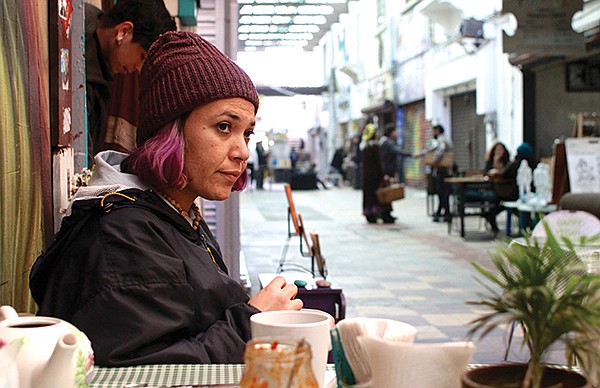
Zurita’s neighbor across the hall is Claudia Lomeli, who runs Happy Vegan. Claudia’s small restaurant is frequented by people who often see the zonkeys as a form of animal abuse and torture.
“When I asked them,” Zurita says, “what will happen to the families that depend on the zonkeys, they shrugged it off and told me that that’s not their problem. They care more about animal lives than human lives.... They are traitors, and this place has way too many of them. I am trying to bring Tijuana to the world. I am organizing a tribute to Herb Alpert here in Pasaje. I am trying to sell real art, bring some money into the community. But the people around me don’t seem like they are interested. They’d rather complain about the donkeys.”
As I said goodbye to Zurita, I saw Lomelia arriving on her bike at her small shop.
“I have nothing against [Zurita,]” she says, “[but] I have seen the donkeys mistreated. They are out there in the sun. They barely have food. They eat leftovers.”
As a vegan and animal lover, Lomeli wants the animals to be taken off the streets and moved to a donkey sanctuary.
“If we can’t do anything at the moment, I would like to have a campaign to get them more food and water. I am aware of Victor’s argument that they are the best treated donkeys in the world. But the donkeys could have a better life. They seem unhealthy. I don’t like seeing how they hit them if they don’t obey. I’ve seen heavy tourists getting on the donkey to pose. The treatment they receive is not congruent with what Victor says about being the best-treated donkeys. If they had better food, roof, and better treatment, I would not have that much of a problem with the zonkeys.”
Lomeli acknowledges that even if the donkeys had more humane treatment, it won’t stop other animal-rights activists such as Igualdad Animal from protesting.
“I used to be like them,” she says. “I support them and have been part of the protests. But I am a happy vegan, not a hardcore one.”
“The purpose of Igualdad Animal is to work to end the use and exploitation of all animals as well as support laws approving focus on animal rights,” spokesman Alonso Verdugo tells me via Facebook messenger. “We do street-side informative sessions on foot regularly, approximately two or three a month in different points of the city. But for the painted donkeys, we mainly do it on Avenida Revolución.
“The law will determine what will happen to the donkeys. If the legislators propose the donkeys stay with the owners, the owners will do whatever they want. We propose to put them in sanctuaries that have already been established so the donkeys could live an ethical life free of exploitation.”
I ask Verdugo if there is a possibility for middle ground.
“Middle ground is impossible if you are talking about exploiting another living being. We can keep the tradition of taking pictures in Revolución, just without live animals. More than just complaints, we seek to educate the people about the situation the animals live in all places that an animal is used as a resource to exploit. The abuse is already documented. Every picture with a painted donkey is proof of how we use animals for our own benefit. We have several pictures of our sessions on the Facebook page, Igualdad Animal Mexico.”
The Facebook page of Igualdad Animal is filled with vegan and animal-rights propaganda, not only for the city of Tijuana, but all over the Mexico and the world. Animal-rights groups, with the help of the Mexican green political party, Partido Verde, won a battle on July of 2015, prohibiting the use of animals in circuses. I recall circuses announcing they were in town by parading an emaciated tiger on the back of a flatbed truck with music blasting at full volume.
Though the battle was won, the war seems to have been lost. More than a thousand animals were sacrificed, as the owners could not sell them; and with no means of income, they could not feed them, either. The next battle that seems to be on the agenda is prohibiting bullfights, a movement that has taken hold in both Mexico and Spain.
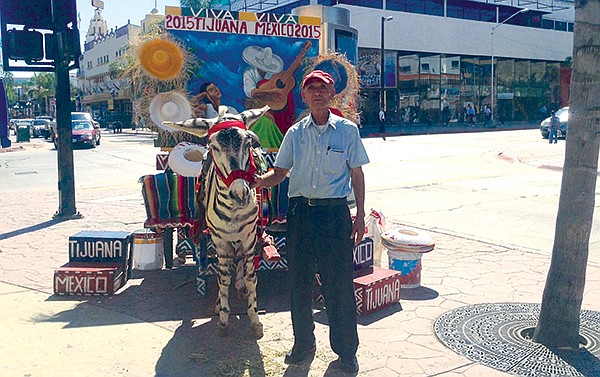
I approached a zonkey handler with a donkey named Bimbo and asked the handler if he would respond to a few questions.
“I shouldn’t answer questions. You want to talk to Jorge Bonilla; he is our representative and the one that has been answering questions to reporters.”
He told me that I would find Bonilla on the next corner the following day. That day was his day off.
I went out looking for him the following day. I took my time walk ing around Avenida Revolución and familiarizing myself with the donkeys. I jotted down the names of every donkey on the street: Monica, Ruben, Barbi, Bimbo, Beva, and Paco. Of the six donkeys, two of them were in the sun, partly covered by the shade of a palm tree. They all had pieces of corn and other food. One beast’s paint was so faded he was closer to donkey than zonkey.
“I have been doing this for 73 years,” Bonilla says when I find him with his zonkey. “I am not a representative; I am just the one that has been doing it for the longest time, so people trust what I have to say.”
Bonilla, a humble, scrawny old man with glassy eyes and skin wrinkled and tanned after seven decades outdoors, does not know another life but this.
“Animal rights have been around for a while, but they took us by surprise and used the zonkeys as a flagpole for their causes. They are only focusing on the donkeys, not talking about the tens of thousands of stray dogs in Mexicali dying on a daily basis. Those are wild dogs that attack people and have caused deaths.”
As I talk to Bonilla, his partner tries to get tourists to take pictures with the donkey in an aggressive manner. The donkey licks the handler’s elbow and he slaps the donkey in the face, telling it to calm down.
“Now, in my opinion,” Bonilla continues, “the population of Tijuana and the mayor of Tijuana are in favor of keeping the zonkeys. All the donkeys have an owner that takes care of them, a place to sleep, and their work is minimal. In the rest of Mexico and other nations, donkeys carry firewood and gallons of water uphill, receive worse treatment, and eat less, but the activists turn a blind eye to them. Look at the donkeys here: they are fat — actually, they are overweight. The one behind you is eating alfalfa. They eat all day. His water bucket is full.
“There are around nine or ten donkeys here on Revolución, because we are struggling. Business has been tough. Ever since the towers fell down [9/11], business has kept going down down, down. Right now is low season, so it’s even worse. Yesterday we made one dollar, today we already made $30. So, we earn around minimum wage, sometimes double that. We have no support. This is our only means to feed ourselves to keep a tradition that has been going for more than 100 years.”
The municipal government has authorized 12 spots for zonkeys, “but we don’t use them all,” Bonilla says, “because business is failing. The donkeys only work six to eight hours, and they haven’t worked the night shift in a long time.”
The handlers work in teams of two or three people. The cart behind the donkey is carried by the handlers from their home to the street in the morning and back in the early afternoon. The donkey’s only job is to look pretty for the pictures and, every once in a while, support a sombrero-topped tourist.
“We let tourists take pictures with their own cameras as long as they buy the one we are selling,” Bonilla says. “The pictures come in different sizes. The biggest is $10, the smallest is $5, but there are more sizes. If they don’t want to buy our picture, we charge a reasonable price. But we also inform people about the history of the donkeys, their names, and their treatment. We use old cameras. We can’t afford anything better.”
Bonilla rejects the idea of making it easier for tourists to take their own pictures and simply donate. If a tourist tries to take a picture without permission, the handlers demand money or shoo them away instead of encouraging a friendly interaction. I point out that from the sun’s position in relation to the donkey, the pictures will come out backlit. Bonilla disregards this notion and said the pictures come out fine.
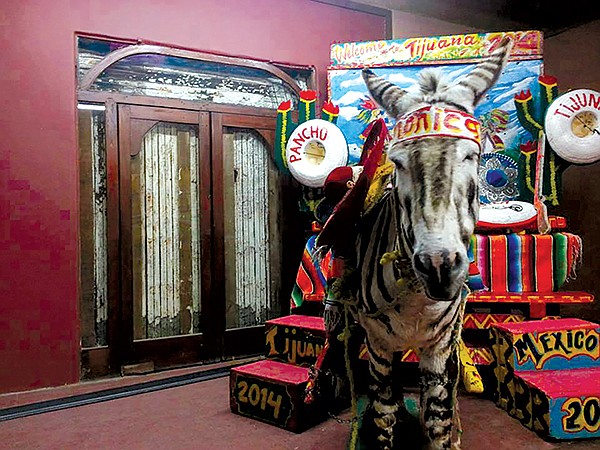
“I once saw Monica the Zonkey chug a two-liter Coke,” says Stuart Carwell, the cook at Tijuana restaurant Voodoo Stu Southern Cuisine. “A lady teased the zonkey with the huge bottle and Monica couldn’t get her eyes off the Coke. Then they held her head up and helped Monica chug the Coke. She [Monica] didn’t burp even though she drank the whole thing. She was really into her Coke.” Carwell has been living in Tijuana with his girlfriend for a bit over a year and says he has witnessed this rare zonkey phenomenon.
“Most donkeys will drink any soda. They also love apples and oranges,” Bonilla says. “There is actually a gringo that comes by almost every morning and feeds all the donkeys some bread. If anyone thinks they don’t get enough food, they can buy an apple and feed them. There have been articles in newspapers claiming that we don’t feed them or give them water — that is just childish nonsense. The businesses around us give us free water; their buckets are always full. We give them corn and alfalfa, they only work six hours, tops, and they rest two or three days a week.”
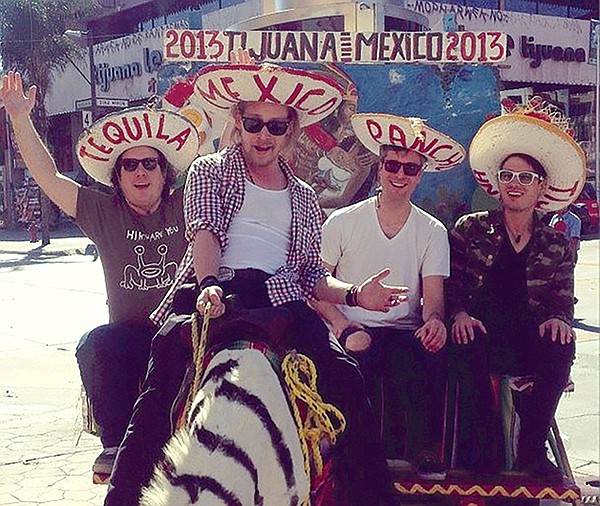
The zonkey business seems to be dying of natural causes, not because of animal-rights activism. The Tijuana street photographer, which was a profitable way to make a living for the past century, has now mostly vanished. A few years ago, you could find street photographers entering every bar and restaurant to try to sell you a souvenir picture. Nowadays, you can only find them in Zona Norte strip clubs, where taking pictures with your cell phone is frowned upon.
My mom recently dug up a picture from a 1978 visit to Tijuana with herself, my dad, my uncle, and my uncle’s then-wife. The photo, like Tijuana’s Zonkey tradition, has faded badly.


Many already know and have taken pictures with them as a souvenir from Tijuana, a tradition that started shortly after the city was founded. The zonkey (burro-cebra in Spanish) is Tijuana’s most enduring icon — it even has its own Wikipedia page. The first known picture of a tourist posing with a zonkey is from 1914.
Back then, the quality of the picture would not expose the sepia-toned donkey. Instead, it looked more like a ghostly figure of the animal. Someone had the genius idea to paint the donkey black and white, resulting in what was known as the Tijuana zebra.
(The offspring of the cross between a zebra and donkey do exist but are mainly found in Africa, not Tijuana. See Zebroids.)
When I first encountered a zonkey in 2009, the donkeys seemed malnourished and the black-and-white paint was mostly faded out. The handlers approached aggressively and asked in English if I wanted a picture, almost forcing me to accept. It was hard times for the handlers. The economy was bad, and tourists had abandoned Tijuana. The slow comeback of tourists since then has given handlers a bit more money in their pockets, but nothing compared to their golden days.
In August of 2014, the zonkey tradition became 100 years old and it was declared a cultural heritage icon. The city’s professional basketball team is nicknamed the Zonkeys. But for the past couple of years, animal-rights activists have been organizing peaceful protests to try to get the donkeys off the street. They intend to replace the donkeys with fiberglass replicas made by local artists, a proposal that has not gained traction.

“No, I do not want to talk about it!” said Victor Hugo Zurita in Pasaje Rodríguez. Zurita runs a small shop that is dedicated to honoring Tijuana and its traditions. He is adamant about protecting the zonkeys. “I am tired of the discussion; it is an insult to my intelligence and to my education.” But he continues to talk about the subject passionately.
“These are the best-treated donkeys in the world!” Zurita pounds his desk with his left fist. “All other donkeys suffer more; donkeys are beasts of burden! I respected their movement at first, but these [activists] are people that are not from Tijuana and do not know what this city is about. I am from here; my grandparents moved here in the 1920s. I do everything for this city, and I am tired of people that have it so easy to just write signs about zonkeys suffering and protest in the street.”
The protesters, Zurita says, “told me they would find sanctuary for the donkeys, but they never provided actual plans, just promises.”

Zurita’s neighbor across the hall is Claudia Lomeli, who runs Happy Vegan. Claudia’s small restaurant is frequented by people who often see the zonkeys as a form of animal abuse and torture.
“When I asked them,” Zurita says, “what will happen to the families that depend on the zonkeys, they shrugged it off and told me that that’s not their problem. They care more about animal lives than human lives.... They are traitors, and this place has way too many of them. I am trying to bring Tijuana to the world. I am organizing a tribute to Herb Alpert here in Pasaje. I am trying to sell real art, bring some money into the community. But the people around me don’t seem like they are interested. They’d rather complain about the donkeys.”
As I said goodbye to Zurita, I saw Lomelia arriving on her bike at her small shop.
“I have nothing against [Zurita,]” she says, “[but] I have seen the donkeys mistreated. They are out there in the sun. They barely have food. They eat leftovers.”
As a vegan and animal lover, Lomeli wants the animals to be taken off the streets and moved to a donkey sanctuary.
“If we can’t do anything at the moment, I would like to have a campaign to get them more food and water. I am aware of Victor’s argument that they are the best treated donkeys in the world. But the donkeys could have a better life. They seem unhealthy. I don’t like seeing how they hit them if they don’t obey. I’ve seen heavy tourists getting on the donkey to pose. The treatment they receive is not congruent with what Victor says about being the best-treated donkeys. If they had better food, roof, and better treatment, I would not have that much of a problem with the zonkeys.”
Lomeli acknowledges that even if the donkeys had more humane treatment, it won’t stop other animal-rights activists such as Igualdad Animal from protesting.
“I used to be like them,” she says. “I support them and have been part of the protests. But I am a happy vegan, not a hardcore one.”
“The purpose of Igualdad Animal is to work to end the use and exploitation of all animals as well as support laws approving focus on animal rights,” spokesman Alonso Verdugo tells me via Facebook messenger. “We do street-side informative sessions on foot regularly, approximately two or three a month in different points of the city. But for the painted donkeys, we mainly do it on Avenida Revolución.
“The law will determine what will happen to the donkeys. If the legislators propose the donkeys stay with the owners, the owners will do whatever they want. We propose to put them in sanctuaries that have already been established so the donkeys could live an ethical life free of exploitation.”
I ask Verdugo if there is a possibility for middle ground.
“Middle ground is impossible if you are talking about exploiting another living being. We can keep the tradition of taking pictures in Revolución, just without live animals. More than just complaints, we seek to educate the people about the situation the animals live in all places that an animal is used as a resource to exploit. The abuse is already documented. Every picture with a painted donkey is proof of how we use animals for our own benefit. We have several pictures of our sessions on the Facebook page, Igualdad Animal Mexico.”
The Facebook page of Igualdad Animal is filled with vegan and animal-rights propaganda, not only for the city of Tijuana, but all over the Mexico and the world. Animal-rights groups, with the help of the Mexican green political party, Partido Verde, won a battle on July of 2015, prohibiting the use of animals in circuses. I recall circuses announcing they were in town by parading an emaciated tiger on the back of a flatbed truck with music blasting at full volume.
Though the battle was won, the war seems to have been lost. More than a thousand animals were sacrificed, as the owners could not sell them; and with no means of income, they could not feed them, either. The next battle that seems to be on the agenda is prohibiting bullfights, a movement that has taken hold in both Mexico and Spain.

I approached a zonkey handler with a donkey named Bimbo and asked the handler if he would respond to a few questions.
“I shouldn’t answer questions. You want to talk to Jorge Bonilla; he is our representative and the one that has been answering questions to reporters.”
He told me that I would find Bonilla on the next corner the following day. That day was his day off.
I went out looking for him the following day. I took my time walk ing around Avenida Revolución and familiarizing myself with the donkeys. I jotted down the names of every donkey on the street: Monica, Ruben, Barbi, Bimbo, Beva, and Paco. Of the six donkeys, two of them were in the sun, partly covered by the shade of a palm tree. They all had pieces of corn and other food. One beast’s paint was so faded he was closer to donkey than zonkey.
“I have been doing this for 73 years,” Bonilla says when I find him with his zonkey. “I am not a representative; I am just the one that has been doing it for the longest time, so people trust what I have to say.”
Bonilla, a humble, scrawny old man with glassy eyes and skin wrinkled and tanned after seven decades outdoors, does not know another life but this.
“Animal rights have been around for a while, but they took us by surprise and used the zonkeys as a flagpole for their causes. They are only focusing on the donkeys, not talking about the tens of thousands of stray dogs in Mexicali dying on a daily basis. Those are wild dogs that attack people and have caused deaths.”
As I talk to Bonilla, his partner tries to get tourists to take pictures with the donkey in an aggressive manner. The donkey licks the handler’s elbow and he slaps the donkey in the face, telling it to calm down.
“Now, in my opinion,” Bonilla continues, “the population of Tijuana and the mayor of Tijuana are in favor of keeping the zonkeys. All the donkeys have an owner that takes care of them, a place to sleep, and their work is minimal. In the rest of Mexico and other nations, donkeys carry firewood and gallons of water uphill, receive worse treatment, and eat less, but the activists turn a blind eye to them. Look at the donkeys here: they are fat — actually, they are overweight. The one behind you is eating alfalfa. They eat all day. His water bucket is full.
“There are around nine or ten donkeys here on Revolución, because we are struggling. Business has been tough. Ever since the towers fell down [9/11], business has kept going down down, down. Right now is low season, so it’s even worse. Yesterday we made one dollar, today we already made $30. So, we earn around minimum wage, sometimes double that. We have no support. This is our only means to feed ourselves to keep a tradition that has been going for more than 100 years.”
The municipal government has authorized 12 spots for zonkeys, “but we don’t use them all,” Bonilla says, “because business is failing. The donkeys only work six to eight hours, and they haven’t worked the night shift in a long time.”
The handlers work in teams of two or three people. The cart behind the donkey is carried by the handlers from their home to the street in the morning and back in the early afternoon. The donkey’s only job is to look pretty for the pictures and, every once in a while, support a sombrero-topped tourist.
“We let tourists take pictures with their own cameras as long as they buy the one we are selling,” Bonilla says. “The pictures come in different sizes. The biggest is $10, the smallest is $5, but there are more sizes. If they don’t want to buy our picture, we charge a reasonable price. But we also inform people about the history of the donkeys, their names, and their treatment. We use old cameras. We can’t afford anything better.”
Bonilla rejects the idea of making it easier for tourists to take their own pictures and simply donate. If a tourist tries to take a picture without permission, the handlers demand money or shoo them away instead of encouraging a friendly interaction. I point out that from the sun’s position in relation to the donkey, the pictures will come out backlit. Bonilla disregards this notion and said the pictures come out fine.

“I once saw Monica the Zonkey chug a two-liter Coke,” says Stuart Carwell, the cook at Tijuana restaurant Voodoo Stu Southern Cuisine. “A lady teased the zonkey with the huge bottle and Monica couldn’t get her eyes off the Coke. Then they held her head up and helped Monica chug the Coke. She [Monica] didn’t burp even though she drank the whole thing. She was really into her Coke.” Carwell has been living in Tijuana with his girlfriend for a bit over a year and says he has witnessed this rare zonkey phenomenon.
“Most donkeys will drink any soda. They also love apples and oranges,” Bonilla says. “There is actually a gringo that comes by almost every morning and feeds all the donkeys some bread. If anyone thinks they don’t get enough food, they can buy an apple and feed them. There have been articles in newspapers claiming that we don’t feed them or give them water — that is just childish nonsense. The businesses around us give us free water; their buckets are always full. We give them corn and alfalfa, they only work six hours, tops, and they rest two or three days a week.”

The zonkey business seems to be dying of natural causes, not because of animal-rights activism. The Tijuana street photographer, which was a profitable way to make a living for the past century, has now mostly vanished. A few years ago, you could find street photographers entering every bar and restaurant to try to sell you a souvenir picture. Nowadays, you can only find them in Zona Norte strip clubs, where taking pictures with your cell phone is frowned upon.
My mom recently dug up a picture from a 1978 visit to Tijuana with herself, my dad, my uncle, and my uncle’s then-wife. The photo, like Tijuana’s Zonkey tradition, has faded badly.
Comments